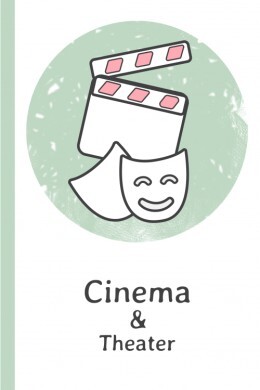a filmmaking technique that uses pre-existing or intentionally recorded audio or video footage to create a sense of authenticity or realism in a new production
Cinema and Theater - Cinematic Techniques and Film Editing
Here you will learn some English words related to cinematic techniques and film editing such as "closeup", "montage", and "flashback".
review
flashcard
spelling
quiz

a technique that allows for precise and repeatable camera movements and is often used for special effects in film and television
a technique in filmmaking where a camera is set up to follow a predetermined path or movement, usually using a computer-controlled camera crane or dolly
a cinematic technique where a single frame is repeated and played back, creating the illusion of a still image
a cinematic technique that uses a sudden and unexpected sound, image, or event to startle and frighten the audience, often used in horror movies
a technique used in video production where still photographs are panned and zoomed in a way to create a video effect
a cinematic technique where the camera is positioned below the subject, shooting upwards, making the subject appear taller, more powerful, or more dominant
a film scoring technique where the music closely follows the on-screen action, emphasizing or mimicking the movements of the characters or objects
a television and film production technique that uses multiple cameras to capture different angles of a scene simultaneously, allowing for a more dynamic and immersive viewing experience
something that is not visible on the screen but exists within the story, such as sounds, dialogue, or actions happening off-camera
a filmmaking technique that combines real-time computer graphics and live-action footage, allowing filmmakers to create highly realistic and immersive environments and effects on-set during filming
a camera angle that shows one character from the perspective of another, commonly used in dialogue scenes in film and television
a technique that merges photographic images with animation to create a moving image, often used to add dynamic movement to static images in filmmaking, advertising, and other visual media
a film and theater technique that uses multiple screens or projectors to create a single, panoramic image, providing a more immersive and visually stunning viewing experience
a camera shot that shows a character's response, typically a facial expression or body language, to something happening off-screen or to another character's actions or dialogue
a filmmaking technique that involves using handheld or mobile camera setups to create a sense of realism and natural movement in the footage
the process of modifying a stage set or scenery during a performance to show a different place or time, creating the illusion of multiple settings without needing separate stages
a filmmaking technique where the camera is intentionally made to shake or move rapidly, often used to create a sense of realism or urgency in the scene
a filming technique that uses only one camera to capture footage, creating a more cinematic look and feel often used in television shows and movies
a cinematographic technique where the camera follows a character closely from behind, often used to create a sense of tension or unease in the audience
a technique where the camera is mounted on a moving platform and follows the action being filmed, creating a smooth and dynamic shot that can follow characters or objects through a scene
a filming technique where the camera is placed inside the trunk of a car, often used to create a sense of confinement or show the perspective of a character trapped in the trunk
a filming technique where the camera lens is blurred or made less sharp than usual, often used to create a dreamy or emotional atmosphere
a camera shot where the camera is tilted to one side, creating a tilted or skewed perspective on the scene being filmed
a detailed and tightly framed photograph or film shot of a subject at close range
a camera shot that is taken from above the subject, often from a high point such as a crane or rooftop, to create a sense of vulnerability or inferiority
a camera shot that captures a broad view of a scene or setting from a distance, often used to establish the setting or provide context
a camera shot that captures a subject from the waist up, providing a balance between the subject and their surroundings
a film editing technique that alternates between different scenes or storylines to create tension or show simultaneous events
a shot that interrupts the main action to show something else, such as an object or a reaction shot
a film editing technique in which one image gradually fades out while another gradually fades in, producing a smooth visual transition
a wide angle shot that shows the location or setting of a scene, often used at the beginning of a sequence to orient the audience and provide context
a film editing technique that uses rapid and frequent cuts between shots to create a sense of urgency or to convey fast-paced action or emotion
a close-up shot of an object or detail, often used to emphasize or highlight a specific aspect of a scene or to provide additional information to the audience
a transition where the audio from the next shot begins before the video from the previous shot ends, creating a smooth and seamless transition between scenes
a type of video or audio edit where the audio from the previous scene continues to play over the footage of the next scene
a technique or process of selecting, editing, and pasting separate footage in order to create a motion picture
a camera technique that presents the viewpoint of a character, showing what they are seeing as if the audience is looking through their eyes
a film or video transition where one image is gradually replaced by another in a specific pattern
a long take that spans an entire scene or sequence, with no cuts or interruptions in the camera movement or action
a technique in film and video editing where a sudden cut from one shot to another creates a jarring visual effect
the technique of using a slower pace to transition between shots, often to create a more deliberate or dramatic effect
a shot taken from an angle opposite to the one used in the previous shot, often used in dialogue scenes to show both characters' perspectives
a film editing technique that maintains the same camera angle while cutting from one shot to another
a film processing technique used in the production of movies that results in a high-contrast, desaturated appearance with a metallic sheen
a film editing technique that shows a character looking off-screen, followed by a cut to a shot of what they were looking at, creating a sense of continuity and spatial coherence
a film editing effect where a sequence of shots are edited together to create a particular meaning or emotion in the viewer
a scene in a story line that interrupts the chronological order and takes the narrative back in time
a cinematic technique where a camera is mounted on a crane to capture high-angle or sweeping shots
a technique or material used in film and photography to block or obscure parts of an image or scene, often for special effects work or to combine separate elements into a single shot
the position and height of the camera in relation to the subject, which affects the perspective and emotional impact of the shot
a storytelling technique where characters from different cultures or languages speak the same language for the ease of the audience
a type of film editing technique where a portion of a shot is replaced by a different shot in a way that is seamless and appears continuous to the viewer
a film technique in which two or more separate scenes are shown on the screen at the same time, often divided by a horizontal or vertical line
